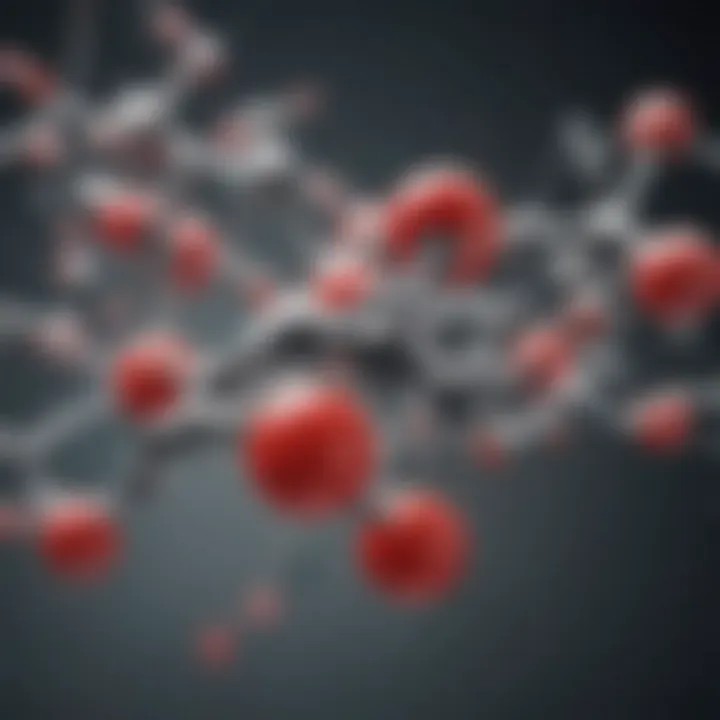Exploring the Composition of Estradiol


Intro
Estradiol holds a significant place among the myriad hormones produced in the human body, specifically as a type of estrogen. It plays a critical role in both the reproductive system and various metabolic processes. Understanding the ingredients that contribute to the synthesis of estradiol is vital for grasping its biological functions and the biochemical pathways involved. With that in mind, this article explores the composition of estradiol, its precursors, and the broader implications for health and therapy.
Summary of Objectives
This section of the article aims to shed light on the intricate ingredients that come together to form estradiol. By examining the precursor substances and the pathways through which estradiol is synthesized, we can gain a better understanding of its role within the body. The objective here is not only to discuss the biochemical nature of estradiol but also to highlight the implications these ingredients can have on overall health.
Importance of the Research
Ingredients of Estradiol
Key Precursors and Biochemical Pathways
Estradiol is synthesized primarily from cholesterol in a multi-step biochemical process. Some of the key precursors involved include:
- Cholesterol: This is the base component from which all steroid hormones are derived.
- Pregnenolone: Considered the first steroid hormone, pregnenolone is a direct product of cholesterol metabolism.
- Progesterone: This hormone is essential for the synthesis of estradiol, especially in the ovarian follicles.
- Androgens (like testosterone): They serve as precursors in the synthesis phase, contributing directly to estradiol production.
The transformation from cholesterol to estradiol involves a variety of enzymes. Each enzyme plays a specific role in this delicate dance of biological chemistry. For instance, aromatase is a key enzyme that converts androgens into estrogens and is fundamental for estradiol synthesis.
Regulation of Estradiol Production
Various factors can influence estradiol levels within the body:
- Age: As individuals age, especially women during the perimenopausal and menopausal stages, estradiol levels tend to decline.
- Health Conditions: Certain medical conditions can lead to hormonal imbalances, impacting estradiol production.
- Lifestyle Factors: Diet, exercise, and stress levels also play significant roles in maintaining appropriate estradiol levels.
- Medications: Hormonal treatments can artificially alter the body’s natural production of estradiol.
Understanding these factors is essential for appreciating how estradiol operates within the larger hormonal ecosystem.
Results and Discussion
Presentation of Findings
Research indicates a complex relationship between the ingredients that contribute to estradiol synthesis and the subsequent effects this hormone has on human physiology. The balance of its precursors not only affects reproductive health but also influences a variety of systems, including the brain, bones, and cardiovascular health. Low levels of estradiol can lead to symptoms such as hot flashes, mood swings, and decreased bone density.
Implications of Results
"Estradiol is not just a hormone; it is a crucial player in maintaining our health and well-being."
Understanding Estradiol
Estradiol, a predominant form of estrogen, plays a central role in various biological functions. Understanding its nuances is vital for grasping how it influences health, disease, and therapeutic treatments. The significance of looking into estradiol extends beyond mere hormone levels; it affects growth, reproduction, and overall wellbeing. Knowledge of its properties can lead to better management of conditions related to hormonal imbalance and reproductive health.
Definition and Significance
Estradiol is a steroid hormone synthesized primarily in the ovaries, but also in smaller amounts in other tissues, such as the adrenal glands and testicles. It is a key player in the estrogen family, crucial to the development of female secondary sexual characteristics and the regulation of the menstrual cycle. Its definition does not merely reside in its biochemical structure, but also in its physiological implications. Estradiol impacts bone density, cardiovascular health, mood, and cognitive function, making it essential for a healthy life.
Moreover, fluctuations in estradiol levels are of significant concern. For instance, during menopause, estradiol levels drop, potentially leading to increased risk of osteoporosis and heart disease. Recognizing these insights allows healthcare professionals to tailor their approaches, whether through hormone replacement therapy or lifestyle adjustments. The importance of understanding estradiol thus lies in its decisive role in both physiological processes and clinical outcomes.
Overview of Estrogen Hormones
Estrogens comprise a group of hormones that include estradiol, estrone, and estriol. Each type plays distinct roles, informed by their varying structures and biological activities. Estradiol, being the most potent, is primarily responsible for the maturation of oocytes and regulation of the menstrual cycle. Its influence, however, is not limited to reproductive processes. Estrogens help maintain bone density and modulate fat distribution, impacting metabolic health.
- Estrone: The primary circulating estrogen post-menopause, weaker than estradiol, contributing to hormonal replacement therapies.
- Estriol: Generally produced during pregnancy, its levels increase significantly, but it is far less potent than estradiol.
This trio of hormones interacts constantly, contributing to a delicate balance determined by factors like age, health status, and external influences. Understanding these interactions is crucial for both research and clinical practices, as it provides a comprehensive view of hormonal health.
Maintaining an open dialogue about the hormonal fluctuations and their implications can empower individuals to make informed health decisions.
Chemical Structure of Estradiol
Understanding the chemical structure of estradiol is crucial, as it underpins the compound’s biological functions and therapeutic applications. The structure dictates how estradiol interacts with various receptors in the body, influencing numerous physiological processes. The atomic makeup not only provides insight into the potency of the compound but also illuminates how modifications in structure can lead to variations in function.
Molecular Composition
The molecular composition of estradiol centers around its empirical formula, C184O2. This means each molecule consists of eighteen carbon atoms, twenty-four hydrogen atoms, and two oxygen atoms. This intricate arrangement leads to a steroid structure, which is responsible for estradiol's classification as a steroid hormone. Its core structure consists of four fused carbon rings — a hallmark of steroids — which influences its solubility and its action as a signaling molecule in various tissues.
- Carbon Atoms: They form the backbone of the molecule, creating a framework that affects its three-dimensional shape.
- Hydrogen Atoms: These determine the molecule's reactivity and stability, and help define the overall energy of the compound.
- Oxygen Atoms: They play vital roles in the hormonal activity via hydroxyl (–OH) groups, which enable hydrogen bonding and receptor interactions.
The presence of these elements showcases how estradiol is a carefully structured molecule, facilitating its multifaceted roles in the endocrine system.
Functional Groups and Properties
Estradiol contains specific functional groups that bestow unique properties, crucial for its interaction with target tissues. The most notable functional groups in this molecule include:
- Hydroxyl Groups (-OH): Two hydroxyl groups significantly enhance hydrogen bonding capacity with estrogen receptors, facilitating effective biological action. The positions of these groups also govern the molecule’s ability to dissolve in water versus fatty tissues, impacting its distribution across the body.
- Aromatic Rings: The structure includes a phenolic ring that contributes to estradiol's stability and affects its affinity for estrogen receptors. This aromatic character is a pivotal aspect that enhances ligand binding, making estradiol a potent hormone.
The properties influenced by these functional groups - such as solubility, volatility, and receptor affinity - are critical when considering how estradiol performs its roles biologically, from regulating the menstrual cycle to supporting bone health.
"The intricate dance of functional groups within estradiol makes it not only a significant hormone but also a powerful tool in therapeutic settings."
This detailed examination of estradiol's chemical structure and molecular composition reveals the complexity and significance of this hormone. By understanding its synthesis and structure, one gains valuable insights into how this hormone influences a myriad of biological processes.


Biological Synthesis of Estradiol
The biological synthesis of estradiol forms a critical foundation for understanding this essential estrogen hormone. This process not only highlights the intricate web of biochemical reactions involved but also elucidates the broader significance of estradiol in health and therapeutic contexts. Grasping how estradiol is synthesized offers insights into hormonal balance, reproduction, and various health conditions, making this section crucial for anyone studying endocrinology, reproductive health, or related fields. Moreover, considering the influence of biological synthesis on estrogens can lead to informed applications in medical treatments and lifestyle choices.
Role of Cholesterol
Cholesterol acts as the precursor for all steroid hormones, including estradiol. This fat-soluble molecule is not merely a villain in heart disease; it plays a heroic role within our body’s hormonal orchestration. The synthesis journey begins in the mitochondria, where cholesterol is converted into pregnenolone through enzymatic reactions. Pregnenolone subsequently branches off into multiple pathways that ultimately lead to the production of estradiol.
In essence, without cholesterol, estradiol couldn’t even get started. However, it is vital to strike a balance, as excessively high cholesterol levels can lead to adverse cardiovascular effects while still being necessary for hormonal health. Understanding this duality can help guide nutritional choices and therapeutic interventions pertinent to estradiol levels.
Conversion from Androgens
Estradiol’s formation is notably impacted by androgens, the male sex hormones that also circulate in females. Specifically, testosterone and androstenedione serve as direct precursors in the synthesis of estradiol through a process known as aromatization. During this transfer, aromatase enzymes convert these androgens into estradiol within various tissues, including fat and muscle.
This conversion underscores the interconnectivity between male and female hormones, emphasizing that estradiol is not exclusive to females. Higher levels of testosterone might influence estradiol production, raising potential edges in athletic performance or even implications in polycystic ovary syndrome (PCOS). Therefore, the hormonal balance must be deftly managed, as too much or too little can lead to a cascade of health effects.
Enzymatic Pathways
The enzymatic pathways involved in estradiol synthesis reveal a well-coordinated system essential for maintaining hormonal equilibrium. In this arena, two key enzymes stand out: aromatase and 17β-hydroxysteroid dehydrogenase.
Aromatase Activity
Aromatase is an enzyme crucial for the transformation of androgens into estrogens. It exhibits high specificity, recognizing and converting testosterone and androstenedione primarily into estradiol. This specificity is a significant aspect of aromatase activity, as it allows for finely tuned regulation of estrogen levels in the body. The presence of aromatase is abundant in the ovaries, adipose tissue, and the brain, playing a pivotal role in both reproductive and neurological functions.
One unique feature of aromatase is the influence of various factors on its activity, including age, obesity, and even certain medications that act as aromatase inhibitors. This characteristic leads to important considerations in clinical practices, particularly in managing hormone-related conditions. For instance, enhancing aromatase activity can aid in estrogen production, essential for women experiencing hormonal deficiencies.
β-Hydroxysteroid Dehydrogenase
Another pivotal enzyme involved in estradiol synthesis is 17β-hydroxysteroid dehydrogenase, which plays a fundamental role in converting estrone (a weaker estrogen) to estradiol. This enzyme is essential for maintaining adequate estradiol levels during different life stages, especially during periods of hormonal fluctuation.
What is striking about 17β-hydroxysteroid dehydrogenase is its double-edged sword nature; it can facilitate both the production and metabolism of estrogens, making it influential in the sensitivity of cells to estradiol action. This adaptable role positions the enzyme as significant in research concerning hormone-dependent cancers and other conditions, thus making it a focal point for therapeutic strategies.
Understanding these enzymatic pathways not only illuminates the biochemical landscape of estradiol synthesis but also paves the way for potential innovations in therapeutic hormone regulation.
Natural Sources of Estradiol
Understanding the natural sources of estradiol is crucial to grasp how this significant hormone is produced and regulated within the body. Estradiol, one of the primary estrogen hormones, plays an essential role not only in sexual and reproductive health but also influences various physiological processes across the lifespan. By investigating the natural sources of estradiol, we can better appreciate its vital functions, therapeutic uses, and the potential impact of external factors on its levels. Each source contributes uniquely to the overall homeostasis of this hormone, highlighting the interconnected nature of human biology.
Ovarian Production
Ovaries are the primary production sites of estradiol, especially in females of reproductive age. This synthesis occurs mainly during the follicular phase of the menstrual cycle, when developing follicles stimulate an increase in estradiol levels. Through a series of biochemical reactions, ovarian cells convert cholesterol into androgens, which are then aromatized into estradiol. This process is not just limited to enhancing reproductive function; elevated estradiol levels contribute to various bodily functions, including bone health and cardiovascular integrity.
Moreover, a delicate balance exists here; too little estradiol can lead to issues like infertility or osteoporosis, while too much may raise the risk of certain hormonal cancers.
Adipose Tissue Contribution
It might come as a surprise, but adipose tissue, or body fat, is also a significant contributor to estradiol levels, particularly after menopause. While ovaries gradually decrease in function, adipose cells can take over some estrogen production capabilities. This occurs through the conversion of androgens, primarily testosterone, to estradiol via the action of the enzyme aromatase.
This relationship shows the circuitous, yet crucial link between body composition and hormone levels. In fact, studies suggest that maintaining a healthy level of body fat can positively influence estradiol and overall health. However, excessive fat accumulation may lead to higher estradiol levels, which poses a different set of health risks, such as an increased likelihood of breast cancer.
Placental Influence
During pregnancy, the placenta acts as a remarkable source of estradiol. After conception, estrogen levels rise dramatically, primarily due to the placenta’s production of estradiol. This synthesis is vital for a successful pregnancy, as it helps maintain the uterine lining, supports fetal development, and prepares the body for childbirth by influencing the various physiological changes occurring.
Furthermore, estradiol produced by the placenta also plays a role in regulating maternal metabolism and cardiovascular functions, asserting its importance in the mother’s health during gestation. This connection underscores how different biological systems collaboratively influence estradiol levels, further emphasizing the hormone's complexity and significance.
"Evaluating natural sources of estradiol presents a stunning overview of how multiple systems contribute to its regulation, with implications that reach far beyond reproduction."
The intricate web of ovarian, adipose, and placental contributions demonstrates not merely the sources of estradiol but also the need to understand how alterations in one area can impact the entire hormonal ecosystem. As we delve into the subsequent sections, acknowledging these sources will provide a foundation for understanding the more complex interactions that govern estradiol's biological significance.
Synthetic and Pharmacological Aspects
The synthetic and pharmacological dimensions of estradiol are pivotal when considering its broad therapeutic applications and significance in health and wellness. The ability to manufacture estradiol synthetically opens doors for addressing various hormonal imbalances in the body effectively. Understanding these aspects sheds light on production techniques, formulation strategies, and how they influence the efficacy and safety of estradiol-based treatments. Such insights are valuable for both practitioners and patients aiming to optimize hormonal health.
Estradiol Formulations
Estradiol comes in various formulations, each tailored to specific therapeutic needs. Some common forms include:
- Tablets: Oral estradiol pills provide a straightforward convenience for patients. They are often used in hormone replacement therapy (HRT) and are well-absorbed by the gastrointestinal tract.
- Transdermal patches: This option allows for a steady release of estradiol through the skin, which can reduce fluctuations in hormone levels and minimize digestive side effects.
- Injections: These may deliver a higher dose of estradiol more rapidly, and they can be advantageous for patients who have difficulty with oral administration.
- Vaginal creams and rings: These methods localize estradiol delivery, which can be particularly beneficial for vaginal health without significantly affecting systemic estrogen levels.
Each formulation has its own set of benefits and considerations that healthcare providers must weigh when prescribing treatment regimens.
Mode of Administration
The mode of administration of estradiol greatly influences its absorption, distribution, and overall effectiveness. For instance, oral administration usually leads to first-pass metabolism in the liver, which can alter the bioavailability of the hormone. On the other hand, transdermal or injection methods bypass the liver initially, potentially delivering estradiol more directly into the bloodstream, thus achieving more rapid hormone action.
Key considerations for modes of administration include:
- Patient preference for forms that align with their lifestyle
- Side effects that might stem from oral methods, like nausea, can be minimized through alternative routes
- Pharmacokinetics, which highlight how each method affects hormone levels over time
Therapeutic Uses


Estradiol is utilized in various therapeutic contexts, largely due to its role in regulating numerous physiological functions. The most notable applications include treatment during menopause and as a contraceptive agent.
Menopausal Symptom Relief
During menopause, women often face a myriad of symptoms, including hot flashes, mood swings, and decreased libido, stemming from declining estradiol levels. Hormone replacement therapy, particularly with estradiol, aims to alleviate these discomforts substantially.
A key aspect of menopausal symptom relief includes:
- Quick action: Many women report significant improvement within weeks of beginning therapy.
- 5Benefits of use include:
- Reduction of severe hot flashes
- Improvement in sleep quality
- Enhanced mood stability
However, it’s critical to consider potential risks, such as an increased propensity for thromboembolic events or breast cancer, which necessitates careful patient evaluation and monitoring.
Contraceptive Options
Estradiol is also integral to various contraceptive methods. It works mainly by preventing ovulation and regulating the menstrual cycle. Combinations of estradiol with progestin are common in oral contraceptives, providing effective birth control while also managing cycle-related symptoms.
What makes contraceptive options appealing is:
- Dual functionality: They can also alleviate menstrual-related discomfort, making them a two-for-one solution.
- Convenience: Many users appreciate the straightforward regimen of pills or active hormone patches.
However, the choice of contraceptive method must account for individual patient history and needs, because these products can come with different side effects and contraindications that may not suit all women.
In short, the synthetic and pharmacological realms of estradiol extend far beyond its basic hormonal role, marking it a key player in contemporary health care solutions.
Factors Influencing Estradiol Levels
Understanding the nuances of factors that influence estradiol levels is pivotal for grasping how this hormone operates in the body. Estradiol fluctuates based on various internal and external factors, each contributing to its synthesis, metabolism, and overall physiological effects. It is essential for individuals to recognize how these factors can affect their hormonal health, especially during significant life transitions such as puberty, pregnancy, and menopause.
Age and Life Stages
Age plays a crucial role in determining estradiol levels. From infancy to adulthood, hormonal levels undergo massive changes. During puberty, estradiol surges, facilitating the development of secondary sexual characteristics. Women's estradiol levels peak in their late twenties to early thirties and then gradually decline as they approach menopause. This decline can lead to various health complications, including osteoporosis and cardiovascular disease, highlighting the role of estradiol in maintaining health throughout life stages.
Dietary Influences
Diet significantly impacts hormonal health, with specific nutrients playing roles in estradiol production. For instance, phytoestrogens, found in foods like soy products and flaxseeds, can mimic estradiol in the body. These compounds can help balance hormones, particularly during menopause, when estradiol levels drop. On the other hand, diets high in saturated fats may adversely affect hormone levels, potentially leading to an imbalance. A well-rounded diet rich in fruits, vegetables, whole grains, and healthy fats can support optimal estradiol levels.
Environmental Factors
Environmental elements considerably shape our hormonal landscape, often in unseen ways. Two notable aspects include endocrine disruptors and pollution effects.
Endocrine Disruptors
Endocrine disruptors are chemicals that interfere with hormonal functions. These include substances like bisphenol A (BPA) and phthalates found in various plastics and personal care products. They can mimic natural hormones, leading to significant disturbances in estradiol production and regulation, which may raise the risk of hormonal-related disorders.
- Key Characteristics of Endocrine Disruptors:
- Widespread Presence: They are common in everyday products, including food packaging, toys, and cosmetics.
- Subtle yet Substantial Effects: Endocrine disruptors can lead to long-term health issues, often without immediate symptoms.
These disruptors pose unique challenges in assessing their impact on estradiol and reproductive health. Implementing measures to reduce exposure to these substances may protect hormonal harmony.
Pollution Effects
Pollution effects encompass a range of environmental toxins that can also influence estradiol levels. Heavy metals, industrial pollutants, and particulate matter can affect hormone balance and metabolism.
- Key Characteristic of Pollution Effects:
- Health Deterioration: Long-term exposure to polluted environments can lead to endocrine signaling disruption, with potential implications for reproductive health and hormonal stability.
- Chronic Inflammation: Pollutants often invoke chronic inflammatory responses, further complicating hormonal regulation.
As awareness grows regarding the impact of pollution on health, understanding its role in estradiol dynamics is essential for forming effective strategies to mitigate these effects.
The interplay between various factors indicates a complex relationship in maintaining healthy estradiol levels. It's clear that individual choices, such as diet and environmental awareness, can play significant roles in hormonal health.
Metabolism of Estradiol
The metabolism of estradiol is a paramount aspect in understanding its role and effects within the human body. This steroid hormone doesn't just appear out of nowhere; it undergoes a series of intricate processes that transform it from its precursors, ensuring that it functions correctly in various physiological systems. Understanding estradiol metabolism is not only essential for comprehending how hormonal balance affects health but also reveals the potential implications for therapeutic applications.
Excretion Pathways
Estradiol is eventually excreted from the body through several pathways, primarily via urine. As the body processes estradiol, various enzymes work diligently to convert the hormone into more water-soluble metabolites. Two principal pathways of excretion occur:
- Glucuronidation: Here, estradiol is conjugated with glucuronic acid. This change makes it easier to excrete through urine.
- Sulfation: Like glucuronidation, this process adds sulfate groups to estradiol, again enhancing its solublity and allowing the body to eliminate it effectively.
Both methods are significant, as they prevent the accumulation of estradiol in the body, maintaining hormonal balance. Failure in these processes can lead to heightened levels of estradiol, which might result in health issues such as an increased risk of certain cancers or other hormonal imbalances.
"The body's ability to excrete metabolites is crucial for maintaining homeostasis, as it effectively regulates the levels of hormones in circulation."
Role of the Liver
The liver plays a central role in the metabolism of estradiol. As the main organ responsible for biotransformation, the liver processes estradiol through two main phases:


- Phase I Reactions: These reactions introduce functional groups into the estradiol molecule, leading to the formation of various metabolites. The cytochrome P450 enzyme family, particularly CYP1A1, CYP1A2, and CYP3A4, are key players, modifying estradiol into various hydroxylated forms.
- Phase II Reactions: Following the initial modifications, these metabolites undergo conjugation reactions. This step further ensures that estradiol derivatives are more easily excreted, as mentioned earlier.
A compromised liver function can lead to a slowdown in these metabolic processes, causing an imbalance in hormone levels which can have ripple effects throughout the endocrine system.
Biotransformation Products
Biotransformation of estradiol results in several downstream products, each with varying biological activity. Key metabolites include:
- Estrone (E1): Resulting from the oxidation of estradiol; it has similar, though generally weaker, estrogenic effects.
- 2-Hydroxyestradiol: This metabolite is often viewed as protective against certain types of cancer, as it can exert anti-proliferative effects.
- 16α-Hydroxyestrone: This variant has been noted for its potential role in enhancing cancer risk.
Understanding the metabolites produced during estradiol's metabolism is crucial for professionals in the field, as it can inform potential therapeutic strategies and health implications.
The continual transformation of estradiol is more than just a biological function; it significantly influences not only reproductive health but cardiovascular and cancer-related aspects, making its metabolism a vital subject of inquiry in medical and health research.
Clinical Implications of Estradiol
Estradiol plays a pivotal role in various clinical aspects, particularly in relation to hormonal therapies, cancer research, and cardiovascular health. Understanding these implications is crucial not only for researchers but also for healthcare professionals and patients. Estradiol's functions are multifaceted, affecting reproductive health, bone density, and even mood regulation. Therefore, the clinical implications of estradiol extend deep into therapeutic practices, offering benefits and considerations that impact day-to-day health management.
Estradiol in Hormonal Therapies
Hormonal therapies often utilize estradiol to address conditions stemming from hormonal imbalances. It is commonly prescribed in menopausal treatments, serving as a means to alleviate symptoms such as hot flashes, night sweats, and vaginal dryness. Its effectiveness in restoring hormonal levels can greatly influence a patient’s quality of life during this transitional phase. Additionally, estradiol is used in gender-affirming treatments, helping transgender women through the process of hormone replacement therapy.
However, the administration of estradiol is not without risks. Potential adverse effects can include increased blood clotting risks and mood swings. Therefore, ongoing monitoring and adjustments are necessary to tailor treatments effectively.
Estradiol and Cancer
Breast Cancer
The relationship between estradiol and breast cancer is complex yet vital for understanding oncological therapies. Estrogens are known to fuel the growth of certain types of breast tumors. Consequently, therapies that modify estrogen activity, such as selective estrogen receptor modulators, have become a cornerstone in treating hormone receptor-positive breast cancer. Breast cancer is particularly significant to this article due to its prevalence and the role that hormonal therapies can play in management.
Key characteristics of breast cancer include its heterogeneity, where tumors can differ widely in their responsiveness to estrogen. This variation necessitates a personalized approach to treatment. The unique feature here lies in the potential to enhance treatment efficacy through hormones while balancing the risk of exacerbation of hormone-sensitive cancer types.
Endometrial Cancer
Similarly, estradiol's role in endometrial cancer cannot be overlooked. The hormone can influence the growth of the endometrial lining, potentially leading to hyperplasia, which is a precursor to cancer. This aspect is paramount, as it highlights the importance of monitoring estradiol levels in women at risk.
The key characteristic of endometrial cancer is that it tends to correlate with increased estradiol levels, which is why hormone-dependent therapies may not only aid in symptom relief but also bear preventive potential. However, this brings about the unique challenge of balancing necessary hormonal treatments against the risk of stimulating abnormal growth.
Cardiovascular Health
Estradiol is also well-documented for its influence on cardiovascular health. Research suggests that estradiol can have a protective effect on the heart and blood vessels. The hormone helps maintain healthy cholesterol levels and supports vasodilation, which is the widening of blood vessels, improving overall circulation.
Yet, this too is a double-edged sword. While moderate estradiol levels are beneficial, elevated levels may lead to increased risks for thromboembolic events, such as strokes. It is crucial for clinicians to carefully manage estradiol levels, especially in older women or individuals with pre-existing cardiovascular conditions.
"Estradiol's impact spans across therapeutic domains, presenting both opportunities for intervention and challenges that must be navigated with caution."
In summary, estradiol's clinical implications are far-reaching and deeply intertwined with reproduction, cancer management, and cardiovascular health. Awareness of its benefits and risks is essential in shaping effective treatment plans.
Estradiol and Reproductive Health
Estradiol, a prominent estrogen hormone, plays a pivotal role in reproductive health. Its significance extends beyond mere biological functions; it influences a multitude of physiological processes that affect not only fertility but also overall well-being. In this section, we delve into the layers of how estradiol impacts reproductive health, highlighting its importance across various stages of life and its mechanisms of action.
Menstrual Cycle Regulation
Estradiol is a cornerstone of menstrual cycle regulation. Each month, the ovaries produce estradiol which is crucial for the thickening of the uterine lining, preparing it for potential implantation of an embryo. Here’s how this hormone operates through the different phases of the cycle:
- Follicular Phase: During the early part of the menstrual cycle, estradiol levels start relatively low but increase as follicles mature. This rise stimulates the growth of the endometrium, aiming for a fertile environment.
- Ovulation: A peak in estradiol levels occurs just before ovulation, triggering a corresponding surge in luteinizing hormone (LH). This is the moment when an egg is released.
- Luteal Phase: Post-ovulation, estradiol's role shifts. It supports the maintenance of the endometrial lining along with progesterone, crucial in the event of conception.
If pregnancy does not occur, estradiol levels will decrease, leading to menstruation. These cyclic changes underline how essential estradiol is in ensuring that the menstrual cycle runs smoothly.
"Estradiol is like the conductor of an orchestra, ensuring each phase of the menstrual cycle plays its part in harmony."
Fertility and Estradiol
When it comes to fertility, estradiol is heavily involved in both the physiological and hormonal processes that regulate reproductive function. Proper estradiol levels are essential for optimal reproductive health for a few reasons:
- Egg Quality: Research suggests that adequate estradiol levels contribute to better egg quality, essential for successful fertilization. An environment rich in estradiol ensures that eggs have the best possible chance to develop properly.
- Cervical Fluid Production: Estradiol influences the production of cervical mucus, making it conducive for sperm survival and motility during the fertile window.
- Implantation: After fertilization, sufficient levels of estradiol support the implantation of the embryo into the uterine lining. Without the necessary hormonal balance, chances of implantation can dwindle.
In summary, estradiol is not just a hormone; it’s an integral component of reproductive health, impacting everything from the menstrual cycle to fertility outcomes. Recognizing the depth of its influence can guide future research and therapeutic strategies in reproductive health.
Closure
The concluding section of this article on estradiol serves as an essential touchstone, emphasizing the many facets of this vital hormone. Estradiol, as highlighted throughout, is not just a hormonal player but a multitasker within our body's complex systems, influencing everything from reproductive health to potential links with various cancers. Understanding the intricacies of its ingredients and their biochemical pathways underscores the importance of this hormone in both physiological and therapeutic contexts.
Recapitulation of Key Components
The ingredients that pave the way for estradiol's synthesis and function can be categorized into several key components:
- Cholesterol: The parent molecule from which estradiol is derived, showcasing its significance in the steroidogenesis pathway.
- Androgens: Precursors, like testosterone, that get converted into estradiol under specific enzymatic processes.
- Aromatase: This enzyme is crucial for the conversion of androgens to estrogens, further illustrating the complexity of hormonal regulation.
- Nutrients: Various dietary components, such as certain fats, vitamins, and minerals, can influence estradiol levels, highlighting the interplay between diet and hormones.
The synthesis of estradiol is not merely a biological event but a symphony of ingredients and influences that underline its impact on human health. The accurate assessment of these elements enhances our understanding of estradiol’s role in clinical applications and everyday health.
Future Directions in Research
As we look ahead, there are several avenues of research that promise to shed light on estradiol's multifaceted nature:
- Personalized Hormonal Therapies: Research aimed at understanding individual responses to estradiol therapy could lead to more tailored treatment strategies for menopausal symptoms and beyond.
- Impact of Environmental Factors: With rising concerns over endocrine disruptors, studies investigating how pollutants affect estradiol synthesis and modulation are becoming increasingly relevant.
- Longitudinal Health Studies: Larger scale studies tracking estradiol levels across different demographics could provide insight into how it changes with age and various life stages.
- Connections with Mental Health: Exploring the link between estradiol levels and mental health issues, such as anxiety or depression, could uncover new dimensions in hormone research, revealing underlying psychological implications.
In summary, reflecting on the substantial role estradiol plays across a spectrum of biological processes sheds light on its significance. Continued research into its components and influences will not only clarify its role in human health, but also aid in developing effective therapeutic methods—ultimately benefitting a multitude of individuals.















